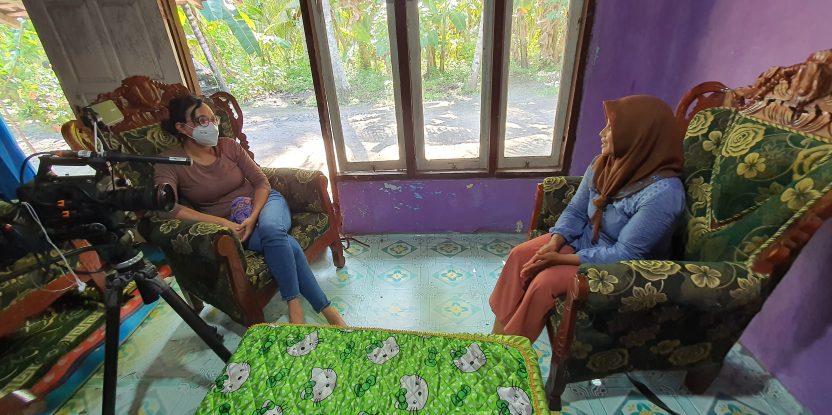
As a food and nutrition scientist in CIFOR-ICRAF, Mulia Nurhasan leads the execution of the food and nutrition component of environmental projects, mostly in Indonesia. Her team comprises four nutritionists, geospatial analysts, and a livelihood specialist. She also leads collaboration between CIFOR-ICRAF and partner institutions, supporting the implementation of research projects in the field. Mulia has a bachelor degree in post-harvest fishery, a master’s degree in international fisheries management, and has a PhD from the University of Copenhagen, Department of Human Nutrition. She is actively involved in advocating for a sustainable food systems agenda in Indonesia.
Q: What does your work look like on a daily basis?
A: My work involves leading the design of projects, building research protocol, liaising with partners institutions, managing research and researchers in the field, managing data analysis, leading the interpretation of findings, leading the process of research publication and writing proposals for research funding.
Q: Why did you become a scientist? What motivates you in your work?
A: I began my career working in development. I knew it was the kind of work I wanted to do from the beginning – I love going to the field, meeting communities, getting to know people with various backgrounds, and contributing to development processes. I am also curious about things, question the mainstream, and love to investigate, write, and share what I find. So being a researcher in development fits my character. But I didn’t know that one could be a researcher in development: I thought researchers belonged to academia, and development was another world. Towards the end of my PhD, things unfolded for me. I met my current mentor, Amy Ickowitz – a senior scientist at CIFOR-ICRAF – with whom I decided to work continuously for sustainable food systems through science and development.
Why is it important to have women leading in science? Do you have a specific example or story you can share?
A: I grew up in an environment that warns women to behave and conform to the general norms. For most of my life, when I speak up against or for something, I am often made to feel bad for doing so. Consequently, like many Asian women who grew up like me, we choose a leadership style that is low key and persuasive. This has been a good approach, but it also has consequences. Sometimes people don’t see women as leaders, doubt our capacity to lead and manage, and hesitate to give us big responsibilities. In many cultures, leading is dominating, leaders must show masculine characteristics.
I feel very fortunate that throughout my career, especially at CIFOR-ICRAF, I have met with great women in science who have many different styles coming from various backgrounds, and they are great scientists, great leaders too! They make me realize that we women do not have to hide our true colours, character and femininity. We can still be great leaders by being who we are and who we are meant to be.
Women of different characters who have taken on leadership roles are playing a vital role in educating our society to accept and provide equal opportunities for women to lead. Their courage to stay true to their characters and bring new types of leadership styles not only inspires more women to embrace their authentic selves but also empowers them to pursue leadership positions. It is not always easy for women to step up to leadership roles. Many of us are not nurtured or shaped for it. But it is unthinkable to design, conduct, and write research without or with very few women in your science group, when half of the target population in research and development work is women. Therefore, women leading in science is a prerequisite to success in our work.
It is not always easy for women to step up to leadership roles. Many of us are not nurtured or shaped for it. But it is unthinkable to design, conduct, and write research without or with very few women in your science group, when half of the target population in research and development work is women. Therefore, women leading in science is a prerequisite to success in our work.
Mulia Nurhasan, CIFOR-ICRAF scientist
This is the second in a series of Q&As with women scientists at the Center for International Forestry Research and World Agroforestry (CIFOR-ICRAF). Ahead of the International Day of Women and Girls in Science (11 February), we asked them what motivates them, any barriers they overcame, what it means to them to be a woman in science, and why it’s important for women to have equitable positions and adequate representation in the sector. Read the first Q&A with bioenergy scientist Mary Njenga.
Read more about Mulia Nurhasan’s work:
- Healthier mangroves, more fish
- Toward a Sustainable Food System in West Papua, Indonesia: Exploring the Links Between Dietary Transition, Food Security, and Forests
- Changing forests, changing diets in Papua
- Food consumption patterns and changes in Indonesia forested and deforested areas
- Caretakers’ perceptions and willingness‐to‐pay for complementary food in urban and rural Cambodia
- Linking food, nutrition and the environment in Indonesia
For more information on Mulia Nurhasan’s work, please contact her at M.Nurhasan@cifor-icraf.org
For more information about CIFOR-ICRAF’s work on gender equality and social inclusion (GESI), please contact Elisabeth Leigh Perkins Garner (e.garner@cifor-icraf.org) or Anne Larson (a.larson@cifor-icraf.org).
We want you to share Forests News content, which is licensed under Creative Commons Attribution-NonCommercial-ShareAlike 4.0 International (CC BY-NC-SA 4.0). This means you are free to redistribute our material for non-commercial purposes. All we ask is that you give Forests News appropriate credit and link to the original Forests News content, indicate if changes were made, and distribute your contributions under the same Creative Commons license. You must notify Forests News if you repost, reprint or reuse our materials by contacting forestsnews@cifor-icraf.org.